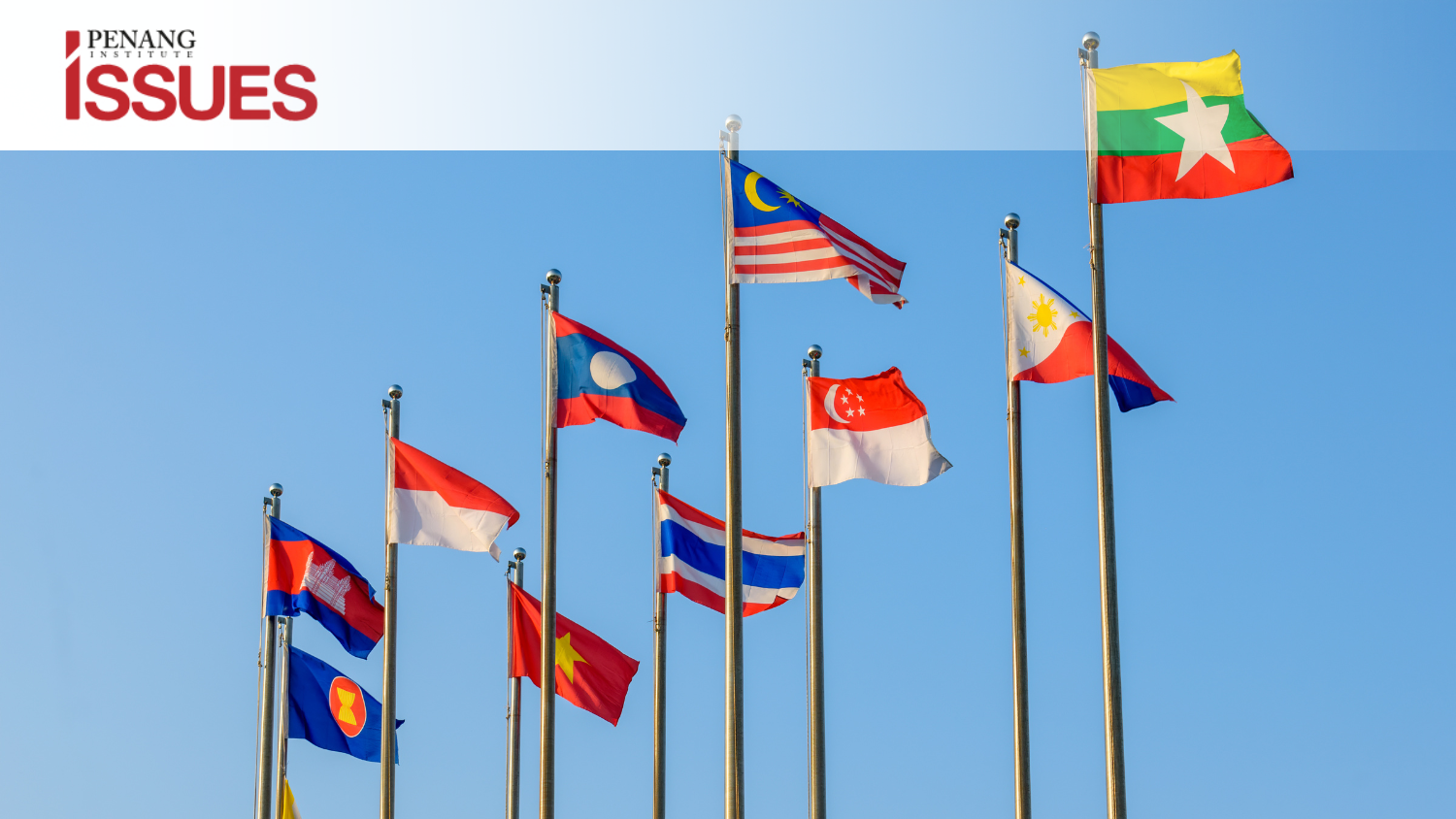
Executive Summary
1. Bidding to Host the 2040 Olympic Games;
2. Establishing an ASEAN BRI Task Force to Strengthen Sub-regional Demands;
3. Positioning Penang as a Prime Candidate for the ASEAN Financial Centre;
4. Establishing an ASEAN Resilience Centre;
5. Creating Urban Marine Sanctuaries for Climate Resilience;
6. Establishing an ASEAN Educational Centre for Technology;
7. Establishing an ASEAN SMEs Facilitation Secretariat;
8. Strengthening connections between creative hubs among ASEAN Members
9. Asserting ASEAN Will to Demand Compliance by Tech Giants
10. Ratifying and Promoting Full Utilisation of Regional FTAs
These recommendations provide a crucial starting point for exploring the complex dynamics
of ASEAN collaboration in the multipolar age in East, Southeast and South Asia
Introduction
This paper is a compilation of ideas for ASEAN integration developed through a special brainstorming session among researchers at Penang Institute. This effort was taken in light of the fact that Malaysia under Prime Minister Anwar Ibrahim will assume the ASEAN chairmanship in 2025.
The format of the brainstorming involved three layers of thinking, from ASEAN to Malaysia, and then to Penang, and vice versa. Our aim is to promote the conviction that integrative regional dynamics are essential to the nation-building achievements of each member state.
The recommendations build upon new concepts, innovative and bold ideas, or strategic suggestions that can inspire actionable solutions.
What we consider a pressing condition for the ASEAN Chair in 2025 to consider is the fast-developing multipolarity in the world, with countries in East, Southeast and South Asia being the most dynamic players in this game changing period. Within such a context, the consensual ASEAN
Way of equating all views from all member states, though probably impossible to change, should allow for tougher G-to-G discussions in light of the risks involved in the decoupling and other processes of global separation that have become trendy.
How can Malaysia under Anwar Ibrahim steer the ten-boat ASEAN flotilla, not merely to reach the safety of port as in earlier chairmanships, meaning survive the year without being responsible for a regional crisis, but to rise instead above the geopolitical storm and take ASEAN to the next level of its collaborative development towards what can be called the “nation-building enhancing regionalism”? During the Cold War, ASEAN was caught in bipolar international superpower relations and it managed to maintain a common stance as the Zone of Peace, Freedom, and Neutrality (ZOPFAN). The present big power rivalry between the United States and China puts ASEAN in new dilemmas—and offers new opportunities. Those opportunities should not be missed.
1. Bidding to Host the 2040 Olympic Games
Few things bring peoples together as much as Sports. Bidding for the 2040 Olympic Games will provide a strong common purpose for the ASEAN member states within a project that provides impetus for infrastructure building, and for regional pride and healthy competition. An ASEAN bid for the Olympic Games through a multicity regional approach may be the only approach that seems practical and realistic enough. National authorities in ASEAN can strongly be encouraged to work collaboratively for the purpose of hosting this most prestigious of international sport events. A bid can sow the seed for deeper relationships, build an international profile for all ASEAN cities involved in providing the facilities for relevant sports. Although winning the bid is not guaranteed, the regional organisation daring to make such a bid will enhance its ontological status even further in the eyes of the world.
2. Establishing an ASEAN BRI Task Force to Strengthen Sub-regional Demands (Little BRIs)
Without doubt, the strongest prerequisite for integration in a region—or in a country for that matter—is transport infrastructure. In fact, this was a key development in Europe when that continent modernised on a large scale in the 1800s. In East and Southeast Asia, where civilisational differences had over the centuries developed their own mix of distance and closeness, territorialism in the form of Western colonialisms encouraged the former more than the latter. The Philippine islands became Spanish, and then American, while the long stretch of islands to its south became Dutch. Northern Borneo and the Malay Peninsula distinguished themselves by being under British control.
In postcolonial times, infrastructure building, already greatly limited within each new country for being too expensive, was sadly further ignored at the regional level. In that sense, the greatest impact that the rise of China over the last 30 years exerts over the region is not only heightened trade, but the real possibility that a quickly-developed transport infrastructure could come into being across the region to stimulate economic development and integration.
However, given the high level of ambition, the huge building capacity and the geopolitical urgency evident on this front in Chinese foreign policy, its smaller neighbours have tended to be uncertain about where the Belt and Road Initiative will take them. Will all roads lead to Beijing? And if they do, how much will it matter domestically in each country? Are the small countries but pawns on a chessboard played by big powers, and if so, how much leeway do pawns in such a chess game have?
For ASEAN, in an age of rising multipolarity, the BRI is a tempting possibility that is at the same time too strongly reminiscent of how many big powers there are in the world. What kind of player ASEAN is to be in a multipolar world is therefore a central question to ask. Each of its member states wishes for economic development on the one hand, and on secured sovereignty on the other.
Where the integrative dynamics of infrastructure building are concerned, ASEAN in 2025 should take the bull by the horns, and establish a BRI coordination task force. China thinks in regional terms, and it would be wise for ASEAN member states to do the same. It might be too much to expect ASEAN to act as one agent, but where BRI projects are sub-national, which they all tend to be, and affect more than one ASEAN country, such a task force should step in to plan and bargain for the best possible deal for all concerned at that sub-national level concerned. In that sense, ASEAN could function as “Little BRIs”, regionally localising larger infrastructure goals to tease nation-building advantages out of the regional infrastructure building that BRI basically is.
3. Positioning Penang as a Prime Candidate for the ASEAN Financial Centre
In 1986, Halinah Todd’s article “Penang: Asia’s ‘Silicon Island'” in Reader’s Digest highlighted the state’s potential to become Malaysia’s next financial and commercial hub, a vision echoed by then-Chief Minister Lim Chong Eu. Given Penang’s existing strengths and strategic location, it is well-positioned to serve as the ASEAN Financial Centre, attracting financial, banking and consulting institutions from across the region.
Penang boasts a thriving technology-based manufacturing and services sector, hosting over 400 multinational companies in electronics, medical devices, engineering, digital and logistics services. This established foundation provides a solid base for developing a vibrant financial centre. In the last decade, more global outsourcing services cutting across business processes, information technology and knowledge management establishing their operations have shown the commitment and confidence of foreign investors in Penang/Malaysia’s skilled workforce and
work culture.
Penang should continue attracting ASEAN financial, banking, and consulting institutions, in realising this potential. By offering competitive incentives, a conducive regulatory environment, and world-class infrastructure, Penang can become a preferred destination for these institutions
where higher-value jobs for business and financial graduates would be created to spur overall economic development.
Expanding the scope of the financial centre beyond traditional banking and finance would further enhance its appeal. Promoting private wealth and equity, family offices, insurance and foreign asset management firms could create a more dynamic and diverse capital market to facilitate capital raising and investment with modern technology and infrastructure investment to support financial services and operations.
The financial centre can also seek financial cooperation for ASEAN+1 given that Malaysia has strong trade relations with most countries. For example, Malaysia could form the China-ASEAN Financial Cooperation Centre to support local finance and economic development through financial sector cooperation and strengthen economic cooperation through investment and trade promotion.
4. Establishing an ASEAN Resilience Centre
An ASEAN Resilience Centre should be established as a collaborative platform to address critical future challenges in the region, including climate change, food security, digital transformation, and socio-economic inequality. By uniting governments, the private sector, academicians, and civil society from ASEAN member states, in crisis management, this platform should generate scalable and sustainable solutions across key sectors. Its focus should cover major issues such as building climate-resilient infrastructure, promoting renewable energy, enhancing disaster preparedness, strengthening healthcare systems, ensuring food security through sustainable agriculture, and fostering economic resilience through diversification and innovation.
A key component of the ASEAN Resilience Center could be a cluster of innovative labs dedicated to climate action, food innovation, digital economy, and social inclusion. These labs could support research and pilot regionally impactful projects, alongside start-up incubators and accelerators for emerging tech companies. While solutions from these labs may be aimed at strengthening the resilience of the region in the long run, immediate solutions for disaster risk reductions should be prioritised, such as an S.O.S mechanism to aid countries hit by natural disasters.
Climate Action Labs could focus on developing innovative renewable energy technologies, such as solar, wind, and biofuels. Additionally, they could explore strategies for adapting to the impacts of climate change, including sea-level rise, extreme weather events, and agricultural challenges. Promoting circular economy initiatives to reduce waste and resource consumption is another key area of focus.
Food Innovation Labs could develop sustainable farming practices like precision agriculture, hydroponics, and organic farming. Research and development of innovative food processing and preservation technologies to reduce food waste and improve food safety are also crucial. Creating nutritious and affordable food products to address malnutrition and food insecurity should be another important goal.
Digital Economy Labs could promote e-commerce platforms and financial technology solutions to drive economic growth and financial inclusion. Exploring applications of artificial intelligence and machine learning in various sectors, such as healthcare, agriculture, and manufacturing, will also be essential. Addressing cybersecurity challenges and ensuring data privacy to protect consumers and businesses should be another key concern.
Social Inclusion Labs could develop technologies that address social inequalities, such as accessibility tools for people with disabilities, and educational platforms for marginalized communities. Supporting community-based initiatives that leverage technology to solve local challenges should also be highlighted. Fostering social entrepreneurship by providing resources and mentorship for startups addressing social and environmental issues should be another crucial area of focus.
A central pillar of the ASEAN Resilience Centre is the sharing of research findings, case studies, and best practices from the abovementioned labs. This hub could be critical in fostering cross-border learning and ensuring that successful initiatives can be scaled across the region.
Additionally, expert networks will facilitate direct collaboration and exchange of knowledge between professionals in key sectors, further deepening regional integration. International partnerships will also play a vital role, enabling ASEAN to tap into global expertise and resources, ensuring that the region stays at the forefront of innovation and development.
5. Creating Urban Marine Sanctuaries for Climate Resilience
Urban marine sanctuaries present an innovative and sustainable approach towards addressing coastal vulnerabilities in Southeast Asia. Unlike traditional marine sanctuaries which are often remote and disconnected from urban centres, urban marine sanctuaries are situated near coastal cities and are designed to be both environmentally beneficial, and accessible to the public.
Urban marine sanctuaries offer several key opportunities:
• Restoration and protection of ecosystems: Coastal habitats such as mangroves, seagrass beds, and intertidal zones are restored and protected, providing critical ecosystem services.
• Climate resilience: Urban marine sanctuaries improve the resilience of urban areas by serving as natural barriers to storms and flooding, while also contributing to carbon sequestration.
• Public engagement and education: These sanctuaries are accessible to local communities, providing opportunities for environmental education and ecotourism.
• Biodiversity conservation: urban marine sanctuaries serve as havens for marine species, helping to preserve biodiversity.
The Middle Bank Marine Sanctuary as the Example
One key example of this efficacious approach is the Middle Bank Marine Sanctuary off George Town. This area is home to a high level of biodiversity, including 102 bird species, 139 species of commercial fish, and various species of shellfish, algae, seagrass, and mangroves. It also hosts vulnerable species such as dolphins, crabs and shrimps.
This sanctuary aims to introduce climate resilience measures to benefit the city of Georgetown, a UNESCO World Heritage site. By restoring ecosystems like mangroves and seagrass beds, the Middle Bank would not only protect against coastal erosion and storm surges but also serve as a natural carbon sink.
Additionally, its proximity to the city offers opportunities for ecotourism, education, and public engagement, aligning with broader sustainable development goals (SDGs) such as Goal 14 (Life Below Water) and Goal 17 (Partnerships for the Goals).
Creating urban marine sanctuaries is a forward-thinking approach to tackling the severest impact of climate change in ASEAN’s coastal regions. By fostering biodiversity, enhancing climate resilience, and promoting sustainable urban development, such sanctuaries provide a model for holistic and scalable solutions across the region. As coastal cities like Penang confront the realities of rising sea levels and extreme weather, urban marine sanctuaries offer a pathway to a safer, more sustainable future.
Shared experience and collaboration using the Middle Bank Marine Sanctuary for ASEAN allows similar models to be developed in the region, as a cogent
example of Malaysian leadership for ASEAN nations.
6. Establishing an ASEAN Educational Centre for Technology
With its strong educational ecosystem, Malaysia is in a good position to promote itself as a regional hub for educational technology (EdTech). It should be able to achieve this by foster partnerships between public and private sectors to develop scalable digital education solutions that are implemented across ASEAN countries. Malaysia could spearhead the development of regional e-learning platforms offering affordable multilingual educational content aligned with ASEAN curricula.
Penang could share its experience creating the 5G Digital Library and Penang Skills Development Centre (PSDC) by developing a blueprint based on that experience, for other ASEAN member states. This could include sharing insights on the hybrid edge solution that Intel helped implement, which combines fast response times with high availability. By offering technical support and guidance, Penang or Malaysia can help other regions replicate the success of this initiative, especially in rural or underserved areas.
Penang’s highly successful collaboration with private firms highlights the power of public-private partnerships. Malaysia, through Penang, could facilitate similar collaborations across ASEAN countries, and allow other regions to tap into the expertise of tech companies to build localised solutions and reliable digital resources which teachers and students can access.
7. Establishing an ASEAN SMEs Facilitation Secretariat
The most problematic factors often cited by small-and-medium-enterprises (SMEs) when considering whether or not to export to overseas markets are (i) the resources required to understand potential/targeting markets and the quality/quantity requirements of foreign buyers, (ii) the prohibitive costs, delays, and other inefficiencies of domestic and overseas transportation, (iii) the costs of imported inputs, (iv) overseas tariff barriers, (v) burdensome customs procedures and corruption at foreign borders, (vi) technical (such as sanitary and phytosanitary) standards and requirements abroad, (vii) complicated and burdensome Rules-Of-Origin (ROO) requirements, (viii) uneconomical production technology and skills, and (ix) lack of access to trade and finance.
This means that no matter how much ASEAN governments call for greater regional economic integration and for SMEs to avail of the free trade agreements (FTAs) signed (whether by the regional organisation collectively or by its individual members) with other nations, tariff and non-tariff barriers remain that only large firms with more sizeable resources can avail of FTAs such as the Regional Comprehensive Economic Partnership (RCEP) or the Comprehensive and Progressive Agreement for Trans-Pacific Partnership (CPTPP).
Hence, exports and foreign trade have generally made up only dismal proportions of SMEs’ operations and revenues: of the RM870 billion in value of goods and services that Malaysia exported in 2020, for example, SMEs contributed only 13.5%. Even stronger economies fare equally badly. For example, Australia’s SMEs contributed only 6% of the total value of the country’s exports in 2015-16.
To bring about the conditions and facilitate SMEs towards availing of the advantages afforded by FTAs, ASEAN should establish an ASEAN SME Facilitating Secretariat that provides to SMEs free-of-charge consultations, opportunities (e.g., fellowships and awards) and assistance to (i) understand and identify ASEAN export and inputs supply markets; (ii) develop models and arrangements that make domestic and overseas transportation feasible for SMEs; (iii) facilitate financing for all stages of SME export costs; (iv) facilitate fulfillment of all legal, regulatory,
customs/border, ROO, and other requirements and to avail of lower tariff and non-tariff barriers, and (v) facilitate technology- and knowledge transfer opportunities to SMEs.
This ASEAN SME Facilitating Secretariat – funded by all member governments in equal/fair proportions of each member’s GDP – would go beyond the knowledge-sharing and expansion of contacts networks, to actual facilitation, assistance and provision of services (e.g., financing) that would enable SMEs to overcome barriers in the export market and avail of the lower tariff and non-tariff barriers agreed to in the FTAs.
8. Strengthening Connections between Creative Hubs among ASEAN Members
For decades, the creative economy has been recognized as a vital driver of economic development in ASEAN countries. With their rich cultural diversity, vibrant art forms, engaged communities, and increasing technology adoption, these nations have significant potential to advance in this sector.
Discussions frequently emphasize the importance of preserving strong cultural identities while fostering collaboration among ASEAN countries to collectively promote the region’s creative economy. The significance of the creative economy has been a recurring theme in leader-level dialogues within ASEAN. The 2023 ASEAN Leadership and Partnership Forum has highlighted that the creative industries have made substantial contributions to Indonesia’s economic growth in recent years. Alongside Indonesia, countries such as Singapore, Thailand and the Philippines have also seen continued growth in their creative economy sectors.
In light of this, therefore, promoting connections between various creative hubs across cities in ASEAN should provide a strong boost to the creative economy in the region. Creative hubs bring together networks of artists, creatives, and communities. Often manifested as physical spaces, these hubs have emerged in many cities across ASEAN, whether supported by government initiatives or private sector investments. They serve as prime examples of place-making processes that transform areas to engage more people and rejuvenate urban spaces. In George Town, Penang, the Hin Bus Depot, established in 2014, was transformed from an old, abandoned bus depot into a thriving community art space for both tourists and local residents. Such efforts are evident in many ASEAN countries, where creative hubs act as dynamic and transformative forces for cityscapes, the creative economy, tourism, and community empowerment.
To maximize their impact, existing networks between creative hubs can be strengthened through enhanced linkages and exchanges, or forums among hub managers, allowing them to share experiences and tackle common challenges.
9. Asserting ASEAN Will to Demand Compliance by Tech Giants
Immense social, economic and political harm – in addition to actual destruction of property, bodily and psychological harm, even violence leading to fatalities – have been documented to be the results, directly and indirectly, of the spread of misinformation/disinformation (known popularly but inaccurately as ‘fake news’) through Internet and Communication Technology (ICT). Such is the size, advanced technology, transnational power and position, and profit interests of social media and digital platforms like X, Facebook, TikTok, and Instagram through which mis/disinformation are spread and amplified, that they are able to dismiss the many efforts and entreaties by ASEAN countries’ civil society organisations (CSOs) and even the individual ministries of ASEAN governments for these platforms to regulate or otherwise moderate the contents and spread of such mis/disinformation.
Given the fact that individual ASEAN governments and even ASEAN’s national economies individually do not command sufficient market or political power to persuade such platforms to act effectively against mis/disinformation, ASEAN as a bloc should assert its collective economic and political powers of persuasion – namely, its currently US$300 billion-digital economy and population of 700 million people – to demand compliance by these platforms. For this to happen, an amalgamation of forces – ASEAN states, civil society, and media organisations – should come together to determine how to assert their collective will against transnational corporations such as Alphabet Inc., Meta, X and other Big Tech entities to ensure that they mitigate the harm resulting from the mis/disinformation that is spread and amplified through their platforms.
10. Ratifying and Promoting Full Utilisation of Regional Free Trade Agreements (FTAs)
As ASEAN chair, Malaysia can take the leading role in encouraging and enhancing regional trade and investment, in order to create a more seamless and integrated economic environment. One of the primary steps involves ratifying and promoting the full utilisation of regional free trade agreements (FTAs), with a particular emphasis on FTAs established with key dialogue partners. These agreements provide a structured framework for the possibility of reducing tariffs and fostering greater market access, which can significantly enhance economic cooperation and
integration across the region.
In addition to taking full advantage of trade agreements, it is essential for ASEAN to facilitate the movement of goods, services, investments, capital, and skilled labour across regional borders. By streamlining processes such as customs procedures and cross-border regulations, businesses can more easily engage in regional trade. Regulatory frameworks across ASEAN members should be streamlined as closely as possible, so that investment opportunities are maximised, and capital can flow freely across the region, fostering a more dynamic investment environment.
Additionally, efforts should be made to increase trade and investment between ASEAN by considering the reduction trade barriers and the elimination of tariffs where possible. This can boost intra-regional trade and ensure that member states are better integrated into the global economy, especially less developed economies such as Laos and Myanmar. By lowering these barriers, a freer flow of goods and services, can be facilitated, enabling member countries to fully capitalise on their respective comparative advantages, stimulating economic growth and development. Such an approach will contribute to a more efficient allocation of resources across the region, leading to higher productivity and enhanced economic well-being for all.
A key strategy to enhance regional cooperation is to minimise business regulations. By streamlining and harmonising regulations, the region can improve the ease of doing business across borders. This should encourage businesses to expand operations regionally, thus promoting a more integrated and robust regional economy. A focus on regulatory cooperation and simplification not only reduces costs for businesses, but also enhances the region’s overall
attractiveness as a destination for investments.
Conclusion
The recommendations presented above serve as a starting point, laying groundwork for a deeper examination of the complex dynamics of collaboration within ASEAN. It is important to recognize that they are merely the first step in an evolving process. These initial suggestions should inspire strategic dialogue and planning that can address the region’s multifaceted challenges. In the long run, they can guide the formulation of actionable policies and collaborative frameworks that strengthen partnerships, drive innovation, and ensure the sustainable development of ASEAN
You might also like:
![Interracial Marriages Getting Popular in Malaysia: Government Support Would be Welcomed]()
Interracial Marriages Getting Popular in Malaysia: Government Support Would be Welcomed
![The Value of Private Member’s Bills in Parliament: A Process Comparison between Malaysia and the Uni...]()
The Value of Private Member’s Bills in Parliament: A Process Comparison between Malaysia and the Uni...
![Podcasts: Challenges and Opportunities for Media Practitioners, Policymakers and Individuals]()
Podcasts: Challenges and Opportunities for Media Practitioners, Policymakers and Individuals
![The Covid-19 Disruption Highlights the Neglected Nature of Arts and Culture Sector in Malaysia]()
The Covid-19 Disruption Highlights the Neglected Nature of Arts and Culture Sector in Malaysia
![Penang’s Economy in the Immediate Post-Pandemic Period: Excelling in a Challenging Environment]()
Penang’s Economy in the Immediate Post-Pandemic Period: Excelling in a Challenging Environment






